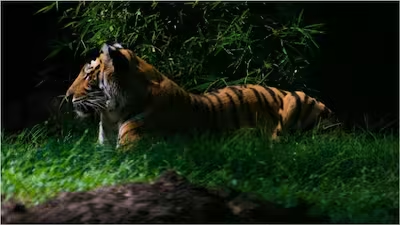
Nothing compares to an Indian wildlife excursion. There is no greater joy than exploring deep woods, hearing the sound of leaves rustling, seeing a deer grazing in the distance, or, with luck, getting a glimpse of a tiger. India’s national parks are rich in culture, mythology, and regional customs, which enhances the experience even more than the animals.
“A safari is not just about chasing tiger sightings,” says Gajendra Singh Rathore, Managing Director of Jungle Camps India. Soaking in the outdoors is the goal. The experience has a way of affecting your spirit and leaving you with lifelong memories, whether it’s the chirping at morning or the quiet of the woodland at sunset.
Which Months Are Ideal for a Wildlife Safari?
Your safari experience may be defined by the season you choose. According to Rathore, “the forest is lush and the weather is pleasant from October to March, making it ideal for first-time visitors.” However, if the objective is to see animals, he recommends the summer. “Animals frequently congregate at bodies of water between April and June, which facilitates sightings.” Remember that because of monsoon rains, the majority of parks are closed from July to September.
How Should Your Wildlife Safari Be Organized?
Making a plan is essential. Safaris travel predetermined itineraries, and national parks have defined hours from dawn to dusk. “It’s best to book both morning and evening safaris to increase your chances of spotting elusive animals like tigers,” suggests Rathore. You may choose between bigger vans for group travel or open jeeps for a more personal experience, depending on your preferences.
All passengers, including children, must have a valid picture ID with them at all times, and safari spots tend to fill up fast on weekends and holidays. For an authentic experience, Rathore advises making reservations for lodging in advance, particularly if you choose to stay in lodges within buffer zones.
What Should I Bring on a Wildlife Safari?
When preparing for a safari, comfort should be the first consideration. According to Rathore, wearing neutral-colored clothes in tones of brown, green, or gray aids in blending in with the environment. Light cotton clothing is appropriate for summertime, while sweaters, scarves, or coats are needed for frigid winter morning jeep trips. Hats, sunglasses, sunscreen, bug repellent, and sturdy shoes are needed.
A camera with a zoom lens and binoculars may enhance the experience, but keep in mind that photography regulations are stringent and that you should turn off the flash. Because phone networks are spotty within woods, it’s also helpful to have a power bank with you.
“The travel is just as important to a safari as the sights you see. According to Rathore, “the forest teaches patience, respect, and appreciation for nature in its purest form.
Activities like nature hikes, village visits, and bird viewing are available at many resorts and campgrounds near national parks. By assisting with species identification and sharing engrossing tales of the forest, hiring a naturalist or guide may enhance the safari experience.
-
Coolie vs War 2: Rajinikanth Starrer Storms Towards Rs 600 Cr, Hrithik Roshan-Jr NTR Film Loses Steam

-
Apple Working On Tiny AI Robot With Movable Display That Follows You Around: Report

-
Magnitude 4.8 Earthquake Strikes Carlsberg Ridge At 10 km Depth, NCS Says Risk Of Aftershocks Remains High

-
'US President Donald Trump Must Exert Pressure To Move Forward On Russia-Ukraine Peace,' Says Former Diplomat Veena Sikri

-
India’s most profitable film, has no big stars, still earned 100 times its budget, ran in theatres for a year, name is…, lead actors are…
